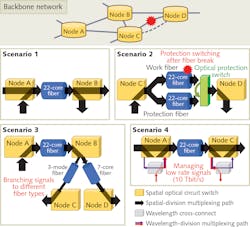NICT demonstrates a 1 petabit per second optical network node
Oct. 18, 2019
3 min read
The Network System Research Institute at the National Institute of Information and Communications Technology (NICT; Tokyo, Japan) has developed and demonstrated the first large-scale optical switching testbed capable of handling 1 petabit per second (Pbit/s) optical signals; this data rate is equivalent to sending 8K video to 10 million people simultaneously.This demonstration made use of state-of-the-art large-scale and low-loss optical switches based on MEMS technology, three types of next-generation spatial-division multiplexing fibers, and included the routing of signals with capacities from 10 terabit per second (Tbit/s) to 1 Pbit/s, which corresponds to more than 100 times the capacity of currently available networks.NICT states that this is a major step forward towards the early implementation of petabit-class backbone optical networks capable of supporting the increasing requirements of internet services such as broadband video streaming, 5G mobile networks, and the Internet of Things (Iot). The results of this demonstration were unveiled at a postdeadline presentation at the 45th European Conference on Optical Communication (ECOC 2019; 22-26 Sept. 2019; Dublin, Ireland).NICT has collaborated extensively with academia and industry to develop new types of optical fiber technologies and provide petabit-class communications for short- and long-reach backbone networks as well as datacenter networks. These included achievements such as the record petabit-class transmission in a single fiber (September 2015 and September 2018) and the longest link using spatial-division-multiplexing amplifiers (March 2019).However, petabit-class transmission requires petabit-class switching technologies to manage and reliably direct large amounts of data through complex networks. Up to now, such technologies have been beyond reach because the existing approaches are limited by complexity and/or performance.
With its state-of-the-art large-scale spatial optical switching, NICT's 1 Pbit/s network demonstration aims at petabit-class next-generation optical networks that use spatial-division multiplexing. The experimental network testbed used three types of multicore fibers and included practical requirements of real networks, such as protection switching. The system was demonstrated in four fundamental scenarios that constitute the building blocks of next-generation optical fiber networks:1. Optical switching of 1 Pbit/s of data2. Redundant configuration to support network failures or fiber breaks3. Branching of 1 Pbit/s signals into different types of optical fibers with various capacities4. Management of lower-capacity 10 Tbit/s signals within the 1 Pbit/s network NICT says that it will continue to pursue the advancement of ultrahigh-capacity telecommunications networks in collaboration with industry, academia, and government.Source: https://www.nict.go.jp/en/press/2019/10/17-1.html
Got optics- and photonics-related news to share with us? Contact John Wallace, Senior Editor, Laser Focus World
Get more like this delivered right to your inbox
About the Author
John Wallace
Senior Technical Editor (1998-2022)
John Wallace was with Laser Focus World for nearly 25 years, retiring in late June 2022. He obtained a bachelor's degree in mechanical engineering and physics at Rutgers University and a master's in optical engineering at the University of Rochester. Before becoming an editor, John worked as an engineer at RCA, Exxon, Eastman Kodak, and GCA Corporation.
Sign up for our eNewsletters
Get the latest news and updates


